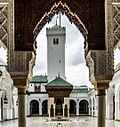Search results
Appearance
There is a page named "Rawd al-Qirtas" on Wikipedia
- Rawḍ al-Qirṭās (Arabic: روض القرطاس) short for Kitāb al-ānīs al-muṭrib bi-rawḍ al-qirṭās fī ākhbār mulūk al-maghrab wa tārīkh madīnah Fās (الأنيس المطرب...7 KB (738 words) - 03:48, 2 April 2025
- relevant major historical texts like the Rawd al-Qirtas by Ibn Abi Zar and the Zahrat al-As by Abu al-Hasan Ali al-Jazna'i do not provide any clear details...109 KB (12,614 words) - 14:33, 5 April 2025
- by Ibn Abi Zar' (d. between 1310 and 1320) in The Garden of Pages (Rawd al-Qirtas) as founder of the mosque. Since she was first mentioned many centuries...22 KB (2,305 words) - 17:46, 12 March 2025
- originating probably from his 14th-century Fez source, the work Rawḍ al-Qirṭās by Ibn Abi Zar, yet Al-'Ibar remains an invaluable source of Berber history. Concerning...12 KB (1,355 words) - 15:47, 7 November 2024
- Al-zaidi)Press, p. 262 Ibn Abī Zarʻ al-Fāsī, ʻAlī ibn ʻAbd Allāh (1340), Rawḍ al-Qirṭās: Anīs al-Muṭrib bi-Rawd al-Qirṭās fī Akhbār Mulūk al-Maghrib wa-Tārīkh Madīnat...35 KB (4,052 words) - 19:22, 2 April 2025
- Equating God, Muhammad and Ahl al-Bayts authority)[clarification needed] Ibn Abī Zarʻ al-Fāsī, ʻAlī ibn ʻAbd Allāh (1340). Rawḍ al-Qirṭās: Anīs al-Muṭrib bi-Rawd al-Qirṭās fī Akhbār Mulūk al-Maghrib wa-Tārīkh Madīnat...144 KB (13,959 words) - 22:12, 1 April 2025in his 1326 Rawd al-Qirtas ("History of the Rulers of the Maghreb"). The town of Moulay Yacoub, outside of Fez, Morocco, is named after Al-Mansur,[citation...12 KB (1,202 words) - 09:57, 12 March 2025
- As-Ṣaḥrā' al-Gharbīyah)September 2009. History of Ibn Khaldun Volume 6, pp80-90 by ibn Khaldun Rawd al-Qirtas, Ibn Abi Zar Besenyo, Janos. Western Sahara. Publikon, 2009, P. 49....111 KB (11,513 words) - 03:02, 25 February 2025
- Al-Adārisah)with the Idrisid dynasty as a way to legitimize their own rule. The Rawd al-Qirtas, written by Ibn Abi Zar in the 14th century, is one of the best-known...36 KB (3,986 words) - 19:03, 22 March 2025
- as a "w" sound. Almoravid dynasty Abu Imran al-Fasi Abdallah ibn Yasin al-Bakri Ibn Khaldun Rawd al-Qirtas "Dar-Sirr: Portal to Moroccan Sufism". Archived...6 KB (603 words) - 10:10, 31 March 2025
- Quran, such as Surat Al-Imran and Surat Yusuf. There is a reference to the phrase in the book Rawd al-Qirtas by Ibn Abi Zara’ al-Fassi, where he described...5 KB (494 words) - 17:35, 22 December 2024
- of the popular and influential medieval history of Morocco known as Rawd al-Qirtas, said to have been written at the instigation of Marinid Sultan Abu...2 KB (183 words) - 02:31, 28 October 2024
- Muslims flags Ibn Abī Zarʻ al-Fāsī, ʻAlī ibn ʻAbd Allāh (1340), Rawḍ al-Qirṭās: Anīs al-Muṭrib bi-Rawd al-Qirṭās fī Akhbār Mulūk al-Maghrib wa-Tārīkh Madīnat...9 KB (893 words) - 17:51, 21 February 2025
- it al-'alam al-mansûr, it had become an emblem for the dynasty and acquired an quasi-mystical status. Ibn Abi Zar describes in his Rawd al-Qirtas of a...7 KB (650 words) - 17:12, 22 December 2024




